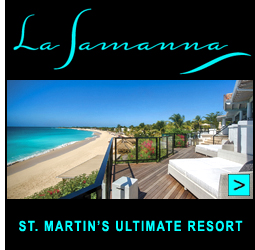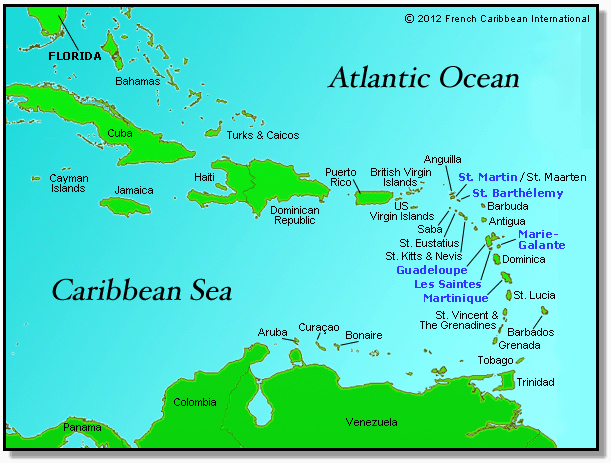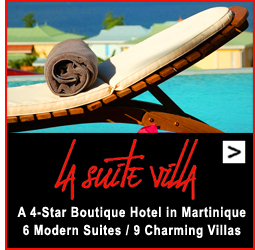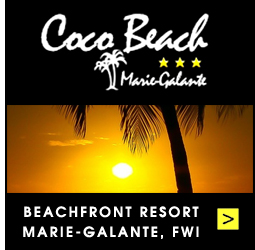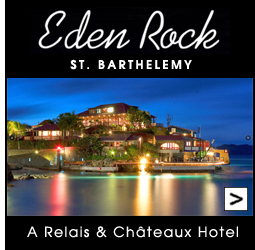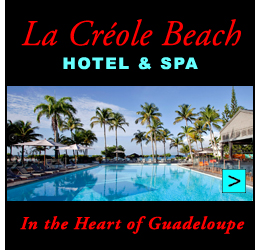Marie-Galante: Description, Beaches, Courtesy
This enchanting island still remains one of the best-kept secrets in the Caribbean. Often referred to as la grande galette (the big pancake) because of its circular shape and relatively flat terrain, Marie-Galante is located about 30 km (18 mi) south of Guadeloupe. Fortunate visitors will discover rolling green hills, turquoise lagoons, picturesque villages and magnificent beaches. The magic of the true Caribbean and its simple rural traditions await within its circular coastline.
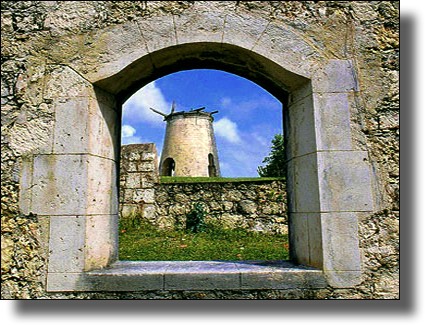
The white sand beaches of Marie-Galante are considered to be among the most beautiful in the entire Caribbean, but they are only the beginning of the island's wonders. Visitors will feel they have moved back in time to an era of charming architecture, nineteenth century windmills and colorful markets. Traditional oxcarts are seen bringing in crops from the cane fields. This is a place of mystical beauty with lush greenery and fascinating historical sites such as the 18th century Château Murat. There are unique natural attractions to explore as well, including the breathtaking Gueule Grand Gouffre (the Mouth of the Giant) and the Trou à Diable (the Devil's Hole) with its subterranean lake. Marie-Galante is a perfect island to explore by car, scooter, mountain-bike or hiking.
The inhabitants of this extraordinary island have, in their wisdom, preserved the timeless quality of Marie-Galante. It remains relatively untouched by mass tourism. About half of the island's population of 11,500 lives in the main town of Grand-Bourg. Most of the others are divided between the coastal villages of Saint-Louis and Capesterre. With an area of about 164 sq km (63 sq mi), Marie-Galante is one of the larger islands in the French West Indies and offers a fascinating new world to explore.
BEACHES
Marie-Galante offers some of the finest beaches to be found anywhere in the Caribbean. On the west coast, lovely beaches can be found at Anse Canot, Moustique, Folle Anse and Trois Ilets. The superb beach at Vieux Fort, north of Saint-Louis, offers picnic facilities, while the sands of Grand-Bourg are protected by a coral reef, making its shallow waters ideal for children. On the east coast, Petite Anse, Les Galets and Anse Feuillard all offer wonderful, unspoiled Marie-Galante beaches. The sensational Plage de la Feuillère at Capesterre is protected by a coral reef. Anse Taliseronde offers excellent snorkeling and views of Dominica.
A BRIEF HISTORY
Known as Aichi by the Carib Indians and as Touloukaera by the Arawak Indians, Columbus arrived on November 3, 1493 and renamed the island after his flagship, Santa Maria La Galante. For more than three centuries, the Carib Indians, French, English and Dutch fought for its treasures. In the 19th century, it finally became French and began to focus its economy on the cultivation of sugar cane. At its zenith, there were over one hundred windmills in operation on the island. Slavery was finally abolished on the island in 1848, due in part to the efforts of abolitionist Victor Schoelcher. Today, sugar production remains as the principal industry, while the island's distilleries produce a potent, high quality rum that is famous throughout the Caribbean. Fishing and tourism are secondary factors in the local economy.
The inhabitants of this extraordinary island have, in their wisdom, preserved the timeless quality of Marie-Galante. It remains relatively untouched by mass tourism. About half of the island's population of 11,500 lives in the main town of Grand-Bourg. Most of the others are divided between the coastal villages of Saint-Louis and Capesterre. With an area of about 164 sq km (63 sq mi), Marie-Galante is one of the larger islands in the French West Indies and offers a fascinating new world to explore.
BEACHES
Marie-Galante offers some of the finest beaches to be found anywhere in the Caribbean. On the west coast, lovely beaches can be found at Anse Canot, Moustique, Folle Anse and Trois Ilets. The superb beach at Vieux Fort, north of Saint-Louis, offers picnic facilities, while the sands of Grand-Bourg are protected by a coral reef, making its shallow waters ideal for children. On the east coast, Petite Anse, Les Galets and Anse Feuillard all offer wonderful, unspoiled Marie-Galante beaches. The sensational Plage de la Feuillère at Capesterre is protected by a coral reef. Anse Taliseronde offers excellent snorkeling and views of Dominica.
A BRIEF HISTORY
Known as Aichi by the Carib Indians and as Touloukaera by the Arawak Indians, Columbus arrived on November 3, 1493 and renamed the island after his flagship, Santa Maria La Galante. For more than three centuries, the Carib Indians, French, English and Dutch fought for its treasures. In the 19th century, it finally became French and began to focus its economy on the cultivation of sugar cane. At its zenith, there were over one hundred windmills in operation on the island. Slavery was finally abolished on the island in 1848, due in part to the efforts of abolitionist Victor Schoelcher. Today, sugar production remains as the principal industry, while the island's distilleries produce a potent, high quality rum that is famous throughout the Caribbean. Fishing and tourism are secondary factors in the local economy.
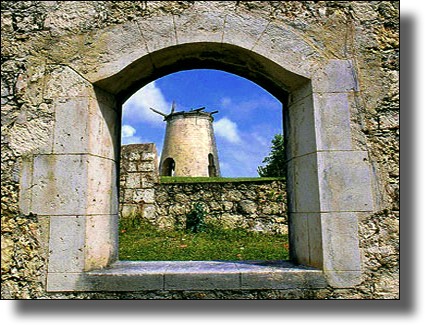
The white sand beaches of Marie-Galante are considered to be among the most beautiful in the entire Caribbean, but they are only the beginning of the island's wonders. Visitors will feel they have moved back in time to an era of charming architecture, nineteenth century windmills and colorful markets. Traditional oxcarts are seen bringing in crops from the cane fields. This is a place of mystical beauty with lush greenery and fascinating historical sites such as the 18th century Château Murat. There are unique natural attractions to explore as well, including the breathtaking Gueule Grand Gouffre (the Mouth of the Giant) and the Trou à Diable (the Devil's Hole) with its subterranean lake. Marie-Galante is a perfect island to explore by car, scooter, mountain-bike or hiking.
The inhabitants of this extraordinary island have, in their wisdom, preserved the timeless quality of Marie-Galante. It remains relatively untouched by mass tourism. About half of the island's population of 11,500 lives in the main town of Grand-Bourg. Most of the others are divided between the coastal villages of Saint-Louis and Capesterre. With an area of about 164 sq km (63 sq mi), Marie-Galante is one of the larger islands in the French West Indies and offers a fascinating new world to explore.
BEACHES
Marie-Galante offers some of the finest beaches to be found anywhere in the Caribbean. On the west coast, lovely beaches can be found at Anse Canot, Moustique, Folle Anse and Trois Ilets. The superb beach at Vieux Fort, north of Saint-Louis, offers picnic facilities, while the sands of Grand-Bourg are protected by a coral reef, making its shallow waters ideal for children. On the east coast, Petite Anse, Les Galets and Anse Feuillard all offer wonderful, unspoiled Marie-Galante beaches. The sensational Plage de la Feuillère at Capesterre is protected by a coral reef. Anse Taliseronde offers excellent snorkeling and views of Dominica.
A BRIEF HISTORY
Known as Aichi by the Carib Indians and as Touloukaera by the Arawak Indians, Columbus arrived on November 3, 1493 and renamed the island after his flagship, Santa Maria La Galante. For more than three centuries, the Carib Indians, French, English and Dutch fought for its treasures. In the 19th century, it finally became French and began to focus its economy on the cultivation of sugar cane. At its zenith, there were over one hundred windmills in operation on the island. Slavery was finally abolished on the island in 1848, due in part to the efforts of abolitionist Victor Schoelcher. Today, sugar production remains as the principal industry, while the island's distilleries produce a potent, high quality rum that is famous throughout the Caribbean. Fishing and tourism are secondary factors in the local economy.
________________________________________
French Caribbean International has been the premier guide to the French West Indies since 1994. We provide a wealth of helpful travel information for visitors to the Caribbean islands of St. Barthélemy (St. Barts, St. Barth, St. Barths), St. Martin / St. Maarten, Martinique, Guadeloupe, Les Saintes and Marie-Galante.

